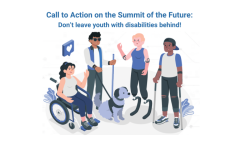Organizations of persons with disabilities (OPDs) have, since long, been advocating for more meaningful allocation of financial resources geared towards the inclusion of persons with disabilities and enabling their full and effective participation. While high income countries in the European Union, for instance, are spending on average 2.1% of their Gross Domestic Product (GDP) on persons with disabilities, data from many low- and middle-income countries reveal that allocations are even less than 0.5% of the GDP.
One of the most effective means of tracing the implementation of the Convention on the Rights of Persons with Disabilities is through understanding the ways in which Governments at all levels have prioritized changing the way they budget for persons with disabilities. For instance, moving away from spending on measures that are exclusionary (institutionalization, special schools, sheltered workshops) to spending that promotes inclusion and mainstreaming (community-based services, inclusive education, disability inclusive social protection). An inclusive recovery will require both increasing public resources dedicated to social protection and support services as well as ensuring that all public funds across sectors are spent in an inclusive way.
States have experienced a loss of revenue on account of lockdowns and an increase in public deficit and debts, and there is a risk that austerity measures will further marginalize persons with disabilities. As they plan to build back better from the impacts of the COVID-19 pandemic, towards the realization of the Sustainable Development Goals (Agenda 2030), Governments must ensure that persons with disabilities, a constituency most impacted by the fallout of the pandemic, are no longer left behind, and that inclusion becomes “the new normal”.
This manual, meant for OPDs, has been developed by the Centre for Inclusive Policy (CIP) and CBM Australia, building on the initial work of the International Disability Alliance (IDA) and the work and experiences of OPDs in the Asia Pacific region that have been working on disability inclusive budget advocacy such as the Equals Centre for Promotion of Social Justice, India, Life Haven-CIL and the Philippine Coalition on the UN Convention on the Rights of Persons with Disabilities, the Access Bangladesh Foundation, the Fiji Disabled Peoples Federation, and the Pacific Disability Forum, the work of many of whom has been supported by IDA.
While this first manual was developed before the crisis, its objective has never been more relevant. We hope that it provides a roadmap for OPDs who are working in this area particularly in the Global South and encourages them to engage further with governments and other civil society coalitions to ensure that the COVID-19 recovery contributes to more inclusive, equitable and progressive mobilization and use of public resources. A volume 2 is being prepared by CIP and IDA in consultations with DPOs and based on their experiences, to provide further insight and guidance on technical issues related to budget analysis and advocacy.
To read the full report in PDF click here.
To read the full report in Word click here.
<<< Go back to Bridge CRPD-SDGs Training Initiative

